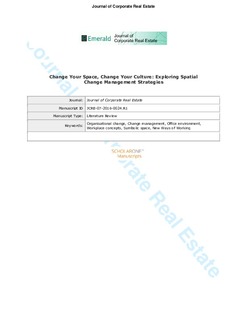| dc.contributor.author | Ekstrand, Mari Anna Chatarina | |
| dc.contributor.author | Hansen, Geir Karsten | |
| dc.date.accessioned | 2018-03-20T08:42:53Z | |
| dc.date.available | 2018-03-20T08:42:53Z | |
| dc.date.created | 2018-01-10T11:50:46Z | |
| dc.date.issued | 2017 | |
| dc.identifier.citation | Journal of Corporate Real Estate. 2017, 19 (2), 95-110. | nb_NO |
| dc.identifier.issn | 1463-001X | |
| dc.identifier.uri | http://hdl.handle.net/11250/2491165 | |
| dc.description.abstract | Purpose
The purpose of the paper is to explore the use of, and challenges associated with, spatial change management strategies. This is done through a discussion on how spatial environments may be utilised to effect organisational change. The intention is to provoke new thinking on physical change initiatives and to challenge the often highly deterministic view on the effects of contemporary workspace concepts.
Design/methodology/approach
The paper is structured as a case study-based literature review, drawing on literature from the fields of environmental psychology, organisational branding, corporate real estate and facility management, as well as organisational change management.
Findings
The study indicates that space management strategies may fail because of the lack of understanding of how organisational events and other contextually specific aspects correlate with the physical change initiative. Succeeding with the spatial strategy requires a strong focus on socio-material relationships and the employee meaning-making process during the spatial change process.
Originality/value
Contrary to the traditional and rational focus on functional space management strategies, the paper takes a socio-material approach suggesting that there is a need for more empirically based research into the employee meaning-making process and the role of human and organisational practices in the development of new workplace concepts. Focusing on how organisational members understand and “make use of” spatial environments may substantially improve organisations and building consultants’ abilities to strategically manage the physical change initiative and achieve the intended ends. | nb_NO |
| dc.language.iso | eng | nb_NO |
| dc.publisher | Emerald | nb_NO |
| dc.title | Change your space, change your culture: exploring spatial change management strategies | nb_NO |
| dc.type | Journal article | nb_NO |
| dc.description.version | submittedVersion | nb_NO |
| dc.source.pagenumber | 95-110 | nb_NO |
| dc.source.volume | 19 | nb_NO |
| dc.source.journal | Journal of Corporate Real Estate | nb_NO |
| dc.source.issue | 2 | nb_NO |
| dc.identifier.doi | 10.1108/JCRE-07-2016-0024 | |
| dc.identifier.cristin | 1539672 | |
| dc.description.localcode | © 2017. This is the authors' manuscript to the article. The final authenticated version is available online at: https://www.emeraldinsight.com/doi/full/10.1108/JCRE-07-2016-0024 | nb_NO |
| cristin.unitcode | 194,61,50,0 | |
| cristin.unitname | Institutt for arkitektur og planlegging | |
| cristin.ispublished | true | |
| cristin.fulltext | preprint | |
| cristin.qualitycode | 1 | |
